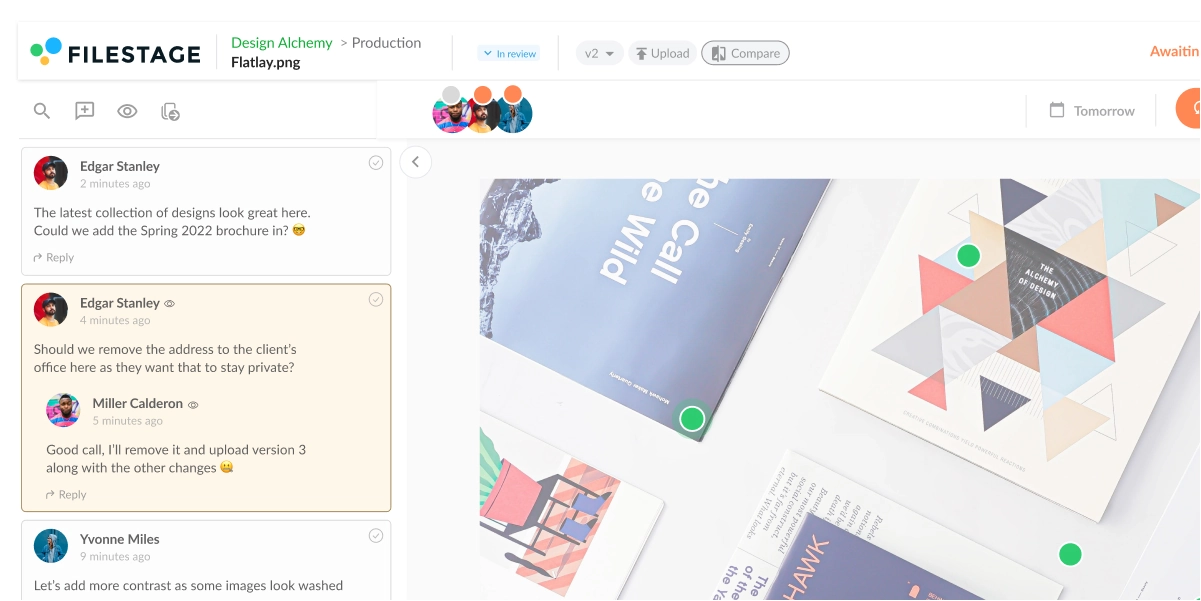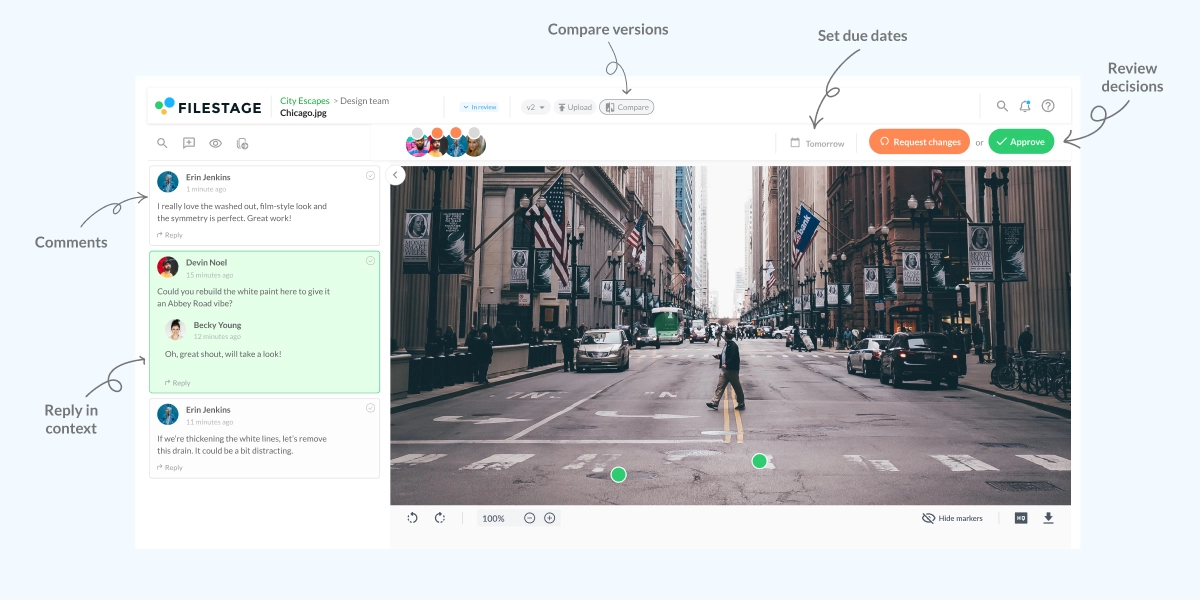A feedback loop is the process of collecting, analyzing, and implementing feedback, and then using those learnings to make your future work even better.
From customer feedback on your products and services to internal feedback on a particular project or policy, feedback loops help you to create your best work and grow in the right direction.
All sound a bit theoretical so far? No worries, it’s a tricky one to get your head around! In this guide I’ll share six feedback loop examples to put that theory into practice. Have a read through and see how you can use feedback loops to improve your project, product, service, or business as a whole.
Six feedback loop examples
1. Creative feedback loops
Creatives often need to collect feedback on their content from a range of stakeholders. This helps to improve their work and get it to the best standard possible. This might be via an internal feedback loop, which involves getting feedback from internal teams, or an external feedback loop, which involves collecting feedback from clients or anyone else outside of the organization.
Feedback tools like Filestage help you to collect this information in one place and make the feedback process more efficient.

The feedback is likely to be varied, with some positive, some negative, and some conflicting. The creative analyzes the feedback and decides what needs to be implemented. Once they’ve made the changes, the first loop is complete.
Then the process restarts, with the creative going back to the beginning of the loop and requesting further feedback until everyone is happy.
Feedback from each project is used to influence future projects too.
2. Project management feedback loops
Project managers continually collect feedback on the way a project has been run and how things can go better next time. These are often called retros or wash-ups.
Then they run another project with those improvements and repeat the process. The aim is to continually improve, making projects more efficient and more enjoyable for everyone involved.
Here are some of the types of projects that could benefit from project management feedback loops:
- Fashion photo shoots
- Animation processes for ads
- Product design
- Website redesigns
3. User engagement feedback loops
Companies often analyze user engagement to help them evolve. By looking at what users engage with, and what they don’t, organizations can pivot their strategy to make their content, products, and services as targeted and as appealing as possible.
Take Netflix.
The streaming service is one big feedback loop. They produce content, publish it, see how many people watch it, then either cancel shows or keep making them. They also use that loop to influence the type of new shows they make.
Other examples of user engagement feedback loops include:
- Content engagement on a blog
- Social media engagement
- Newsletter clickthrough rate
- Feature usage on an app
4. Customer feedback loops
Customer feedback loops are also known as negative feedback loops. But don’t let the name confuse you, as it can refer to both criticism and praise.
Customer feedback – be that positive or negative – gives businesses insight into how their customers feel about their products, their services, or their business as a whole. It helps them know what’s going well and what needs improving.
Complaints and negative feedback prompt change, which then leads to a new round of customer feedback. And a new round of changes.
Positive feedback might mean things stay as they are for now, but continually collecting customer feedback means that if opinions change, so can the product or service.
Ways of collecting customer feedback include:
- Surveys and polls
- Google reviews
- Social listening
- Focus groups and interviews
5. Employee feedback loops
Also known as positive feedback loops (but again, nothing to do with feedback being positive rather than negative), employee feedback loops are used by organizations to gauge how staff feel about company policies and culture.
Employee satisfaction surveys show the powers that be what they need to do to make staff happier. And by making the necessary changes, the hope is that this will improve employee retention.
6. Pricing feedback loops
The price of a product or service shouldn’t be plucked out of thin air. And it shouldn’t be set in stone either. A company will usually carry out market research to set the price of a new product, and from there, customer behavior will indicate whether that price makes sense or not.
If the price is too high, customers might not buy the product. This might prompt the company to reduce the price, which could then encourage customers to make a purchase.
If product sales are through the roof, the company might increase the price to reflect the demand.
This practice is common among startups and big corporations alike.
How to improve creative feedback loop management with online proofing software
Online proofing software like Filestage helps with feedback loop management, from sharing the first version all the way through to sign-off. It allows you to collect feedback from internal and external stakeholders in one place, making each feedback loop faster, more efficient, and more enjoyable for everyone involved!
Here are some of the ways that Filestage helps with feedback management:
- Due dates – to keep your projects on track and help you meet deadlines
- In-context comments – for clear feedback that shows up in real time
- Visual annotations – to bring comments to life and make it clear what needs changing
- To-do lists – to give your team a clear picture of what needs amending
- Version history – to help you keep track of comments and what’s changed
- Review steps – to get files approved by different stakeholders at different stages of the process
- Project dashboards – to help you keep track of who you’re still waiting to hear from
- Integrations – with Dropbox, Google Drive, Slack, Microsoft Teams, and more
- Automations – to reduce manual tasks and speed up content reviews

Final thoughts
I hope these feedback loop examples have highlighted how you can use these processes to improve your project, product, service, or business as a whole.
See for yourself how Filestage can help with your creative feedback loops by starting a free trial →

